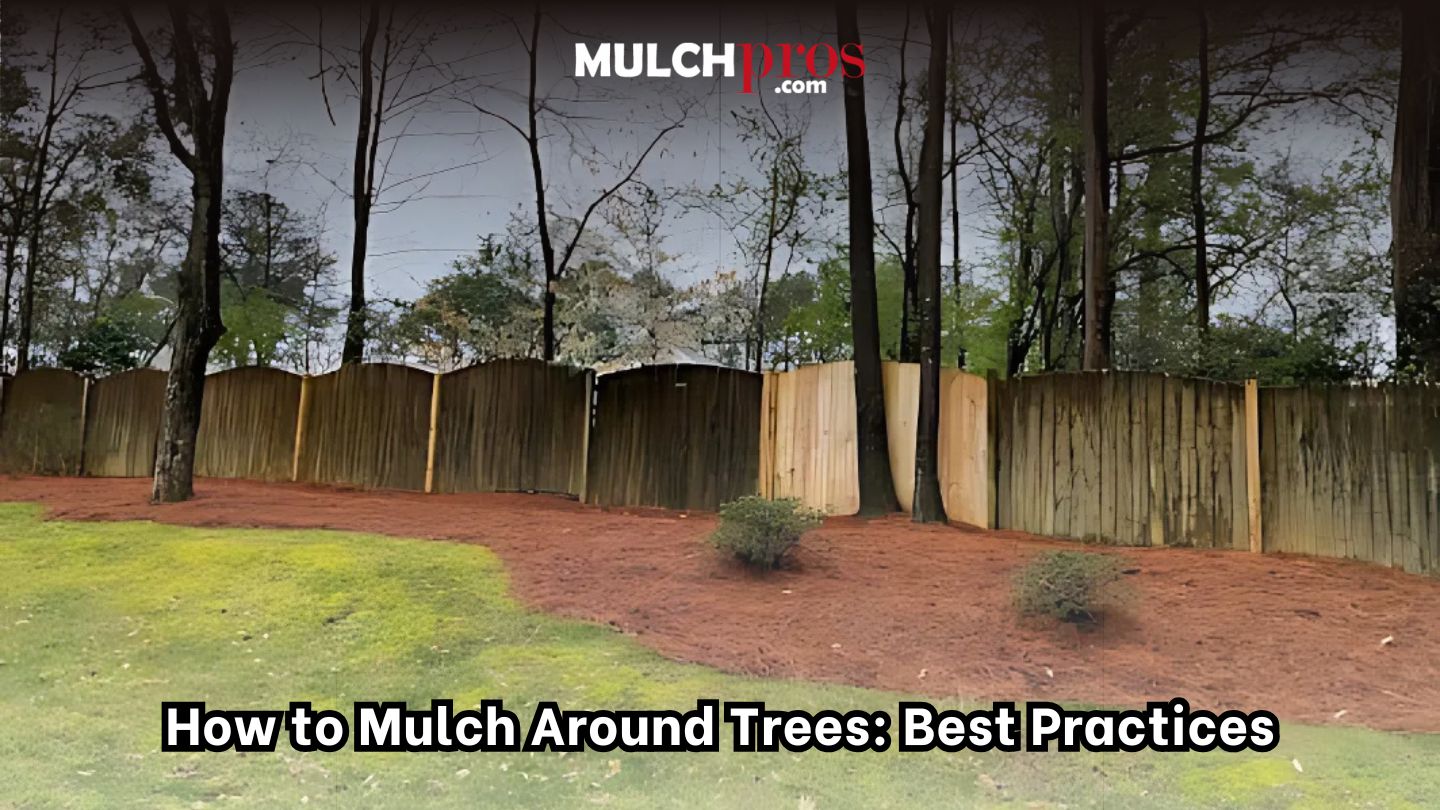Mulching around trees offers numerous benefits, including moisture retention, weed control, and temperature regulation. However, it’s essential to follow proper techniques to ensure tree health and growth. This guide provides best practices on how to mulch around trees, helping you protect the roots and enhance the landscape. By avoiding common mistakes and following these steps, you can improve the overall vitality of your trees and garden.
Key Takeaways
- Proper mulching requires a 2-3 inch layer that avoids suffocation of tree roots and prevents moisture retention against the trunk.
- Organic mulch is preferred for its ability to improve soil quality, retain moisture, and support beneficial microorganisms, while inorganic mulch lacks nutritional value.
- Maintaining mulch involves regular replenishment, monitoring for excess compaction, and ensuring it doesn’t touch the tree trunk to avoid moisture-related issues.
Why Mulching Matters for Trees?
Mulching around trees is essential for more than aesthetics. It retains soil moisture, boosts fertility, maintains root temperature, reduces soil compaction, and prevents weeds. Mulch also enriches soil nutrients, aiding tree growth, especially for new saplings. However, avoid over-mulching as it can suffocate roots and attract pests. Always apply mulch evenly away from the trunk. Organic mulches decompose to improve soil structure.
Choosing the Right Mulch

Choosing the right mulch is vital for achieving the desired benefits. Mulch types include organic and inorganic. Organic mulch, like wood chips, pine needles, bark, and leaves, retains soil moisture, regulates temperature, and improves soil quality and nutrients. They also support beneficial soil microorganisms, contributing to healthier soil.
Inorganic mulch, such as stones or rubber, lasts longer but may create heat issues in gardens. While inorganic mulch provides long-term benefits, it lacks the nutritional value that organic mulch offers. Therefore, for tree health, organic mulches are often the preferred choice despite their need for more frequent replacement due to decomposition.
When choosing mulch materials, consider the specific needs of your trees and soil conditions. Medium-textured mulch, such as cocoa bean hulls, enriches the soil while being attractive and aromatic. By selecting the right type of mulch, you can ensure your trees receive the maximum benefits. However, using too much mulch can lead to root rot, increased insect and disease problems, and other issues.
Preparing the Area Around the Tree
Before laying down fresh mulch, it is crucial to prep the area adequately. Clear away all existing old mulch, debris, and stones in order to reveal the tree’s root flare. By doing this, you eliminate potential barriers that could impede the growth of the tree and facilitate a more accurate evaluation of its health.
Eliminate any weeds that have taken root, as they have the potential to penetrate through new mulch layers and vie with your tree for vital nutrients. Utilize a spade to remove grasses and weeds effectively from around the base of your tree. Ensuring thorough preparation sets up a pristine and robust setting conducive to applying new mulch.
Proper Mulching Techniques
To properly mulch your trees, adhere to essential guidelines that promote their vitality and development. These include applying the appropriate depth of mulch, steering clear of piling it up into “mulch volcanoes,” and forming a mulch ring around the base of your trees as part of proper mulching practices. The tree’s root system is crucial, and different types of mulch can affect the oxygen supply and water retention for the roots, thereby influencing the overall health and stability of the tree.
Read more: How Much Mulch Do You Need?
Correct Depth
Applying mulch at the correct depth is vital. Ensuring that it measures between 2 and 4 inches thick allows for adequate oxygen and water availability, both of which are critical to root health.
If the mulch layer is too thick, it can hinder the roots’ access to oxygen and water, leading to fungal problems and potential suffocation of the roots. By keeping mulch at this optimal thickness, you encourage robust growth in trees while preventing such complications.
Avoiding Mulch Volcano: Preventing Excess Mulch Piled Against the Tree Trunk
Piling mulch excessively against the trunk of a tree, creating what is known as a “mulch volcano,” can have harmful effects. Such excessive use of mulch may cause the root collar to remain overly moist, which increases the risk of decay and pest infestations.
It is important to maintain a space of 1-2 inches between any mulch around a tree and its trunk. Keeping this distance helps in preventing moisture buildup at the base, reducing the chances of rotting or disease occurrence.
When applying mulch around trees, it should be distributed evenly. Thick layers must be avoided so that water isn’t trapped and roots are not deprived of air.
Creating a Mulch Ring
A mulch ring around your trees is both aesthetically pleasing and beneficial. It should extend to the outer edge of the tree’s canopy or drip line, maximizing moisture absorption and encouraging healthy root development.
Ensure no mulch touches the tree trunk to prevent moisture-related issues. A well-defined mulch ring ensures the tree receives the necessary nutrients and retains soil moisture.
Maintaining Your Mulch

Maintaining mulch involves periodic replenishment and monitoring. Organic mulches decompose at different rates and should be replenished as necessary to maintain the recommended depth, ideally in the spring and fall.
Loosen compacted mulch by raking to improve aeration. Removing excess mulch restores proper airflow and prevents fungal growth. Keep mulch away from the trunk to expose the root flare and prevent moisture-related issues.
For over-mulched trees, uncover the root flare and redistribute excess mulch. Proper mulch maintenance ensures the long-term health and vitality of your trees.
Common Mistakes to Avoid When Mulching
Avoid common mulching mistakes to ensure tree health. One major mistake is over-mulching, which can deprive roots of oxygen, leading to tree decline or death. Excessive mulch can also cause root rot, attract insects, and promote disease.
Using grass clippings as mulch can be beneficial, but ensure they are untreated with harmful chemicals. Properly apply grass clippings to promote air circulation and avoid compaction.
Another common error is creating mulch volcanoes, which can suffocate tree roots and lead to improper root formation. Avoid piling mulch against the tree trunk to prevent moisture retention and subsequent rot.
By avoiding these mistakes, you can mulch trees properly and promote their health and longevity.
Benefits of Properly Mulched Trees
Trees that are mulched correctly experience a range of enduring advantages. This not only bolsters the soil’s composition but also nurtures robust root systems and boosts visual appeal. The application of organic mulch contributes vital nutrients to the soil, fostering an environment conducive to vigorous tree development.
By adding a layer of mulch around trees, they are shielded from potential harm inflicted by lawn equipment. Adhering to proper mulching techniques guarantees that your trees flourish, augmenting your garden’s charm through the process of mulching trees.
Conclusion
Proper mulching around trees is essential for maintaining their health and enhancing the beauty of your landscape. By understanding the benefits of using organic mulch and avoiding common mistakes like creating mulch volcanoes, you can ensure your trees thrive. Remember to maintain the correct mulch depth, keep it away from the tree trunk, and regularly replenish it to support healthy root growth and soil structure. With these best practices, you can create a sustainable environment that not only retains soil moisture and suppresses weeds but also enriches the soil with beneficial nutrients. Whether you’re caring for young trees or mature specimens, these mulching techniques will contribute to a flourishing and vibrant garden.
For those seeking the finest in landscape supply in Alpharetta, Mulch Pros Landscapes is your go-to destination. Our expertise in landscape design and high-quality mulch ensures your garden remains healthy and vibrant. Whether you’re enhancing your home’s curb appeal or nurturing a backyard oasis, our team is ready to support your vision. Contact us today, and let us provide the perfect mulch and advice to transform your space.


